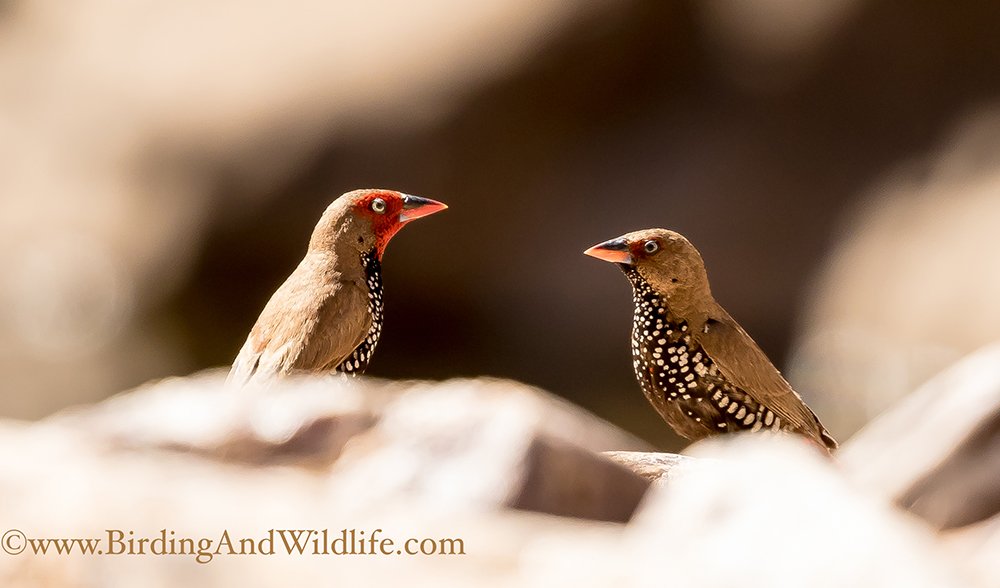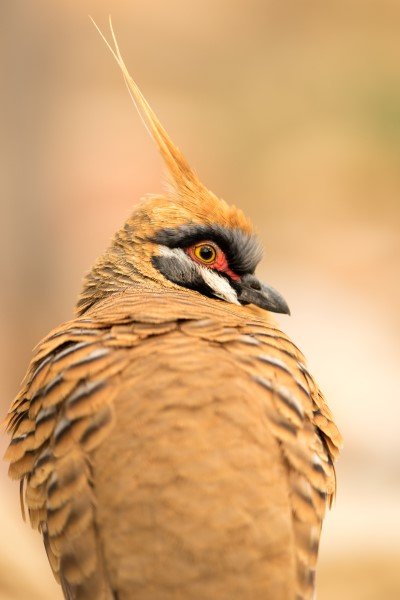10 beautiful birds to look out for in the Red Centre

PICTURE AUSTRALIA’S RED CENTRE, and images of endless desert expanses or the sacred majesty of Uluru and Kata Tjuta most likely spring to mind.
However, visit at the right time of year and you might also be lucky enough to happen upon a flock of tens of thousands of budgies circling a waterhole, or venture out in the cool desert evening to look for the world’s only nocturnal raptor. And with the bird-watching world shocked by recent sensational sightings of the night parrot in Queensland and Western Australia, there is even some speculation the elusive, endangered bird may still inhabit in this region too.
Home to 180 bird species and a range of stunning, diverse habitats, central Australia may be a desert landscape but it’s a bird-watchers oasis – and this 20-24 September, enthusiasts will be flocking to Alice Springs and surrounds for the Red Centre Bird Festival.
Twitching with excitement ahead of the annual event, we asked local bird expert and tour guide Mark Carter to share his pick of 10 birds to put at the top of your list on any bird-watching trip to the Red Centre.
UPDATE! May 2017: Recordings taken by Mark Carter and Chris Watson in southern NT point to a ‘probable’ discovery of the night parrot in this region – meaning your chances of spotting this elusive bird in Australia’s Red Centre just got a little better!
1. Budgies

Image: Mark Carter Birding and Wildlife
These tiny social parrots crisscross the desert in search of the high-energy grass seed that fuels their epic nomadism.
Normally found in small feeding groups when not nesting in river red gums, occasionally they will come together into large flocks to drink. This is the animal at its best, wheeling in the sky like a green and gold shoal of fish as they evade the many predators which feast on them.
Where to see them: These birds can be seen at any time of year at any site, but to see the rare large flocks timing is everything: watch for snap droughts following big rains.
2. Dusky grasswren

Image: Mark Carter Birding and Wildlife
Family-loving songsters of the high ranges, these birds are extremely successful mountain dwellers. Happy to roost and forage in caves, nimbly bouncing up and down scree slopes or fluttering between cliff ledges, these charismatic birds can become very tame, safe in the knowledge that you clumsy humans could never catch them on their rocky habitat!
They are distributed widely across the ranges of the central deserts but it’s possible that some isolated populations could be undescribed subspecies or even completely new species – more research is needed.
Where to see them: Trephina Gorge NP or Simpsons Gap near Alice Springs. A population in the hills around Mary Ann Dam near Tennant Creek with divergent plumage and song is a potential new subspecies.
3. Eyrean grasswren

Image: Mark Carter Birding and Wildlife
Another of the grasswren family, these chunky-billed birds reside in the thick canegrass stands that line the dune crests across the Simpson Desert. A fully omnivorous species with a taste for canegrass seeds, these birds persist in one of the harshest environments on Earth and can even be common in some areas.
Best found by listening for their metallic songs then simply sitting still and watching the area from a vantage point. Be warned though: these birds are nowhere near as friendly as the dusky grasswrens!
Where to see them: The best location in the NT is the dune crests around the Old Andado Homestead south east of Alice Springs.
4. Black-breasted buzzard

Image: Mark Carter Birding and Wildlife
These large dark raptors with prominent white wing patches and short tails are outback specialists, hunting reptiles and rabbits with ease. They are also one of only two carnivorous birds to have evolved tool use, using rocks to smash into emu eggs.
Where to see them: Regularly sighted along the Stuart Highway between Alice Springs and Tennant Creek. A great excuse for a road trip!
5. Painted finch

Image: Mark Carter Birding and Wildlife
Another mountain loving-species, these beautiful black and red finches nest in loose colonies in thick spinifex stands.
Where to see them: On the ridges and waterholes of the McDonnell Ranges and hills around Mary Ann Dam at Tennant Creek.
6. Letterwing kite

Image: Mark Carter Birding and Wildlife
The world’s sole nocturnal raptor, these rare birds invade into the NT during post-rain rodent booms. They roost in whatever tall trees they can find by day then fly off after dark to hunt plains mice and long-haired rats.
Where to see them: The only reliable location is the Mac Clarke Conservation Reserve south east of Alice Springs, but choose your year wisely – in dry times the birds are nowhere to be seen!
7. Rufous-crowned emuwren

Image: Mark Carter Birding and Wildlife
If not for the length of its thin tail this bird would easily be the smallest in Australia. They live entirely in thick old growth spinifex in family groups, scurrying around like mice staying in contact with each other with shrill peeps which are too high-pitched for many people to hear.
Best looked for at dawn and dusk, usually heard before they are seen (if they are visible at all!).
Where to see them: Ormiston Gorge “Pound Walk” and AWC Newhaven Reserve.
8. Spinifex pigeon

Image: Mark Carter Birding and Wildlife
An extraordinary small pigeon with short legs, a round body and a tall vertical crest, these mountain-inhabiting birds live in family flocks and migrate up and down the rocky slopes in search of food, water and safe roosting places. At locations with regular water supplies (such as dripping taps or air conditioners!) they can become remarkably tame.
Where to see them: Alice Springs Desert Park, Trephina Gorge National Park and Ormiston Gorge.
9. Inland dotterel

Image: Mark Carter Birding and Wildlife
An elegant but wary inhabitant of the extensive gibber plains south and east of Alice Springs, these birds turn nocturnal in hot weather and by day rely on their cryptic camouflage to stay safe on the featureless plains they call home.
Where to see them: Mac Clarke Conservation Reserve and Henbury Meteorite Craters Conservation Reserve.
10. Grey honeyeater

Image: Mark Carter Birding and Wildlife
Despite being a furtive, easily overlooked monochrome bird with few distinguishing features, for birders the grey honeyeater is one of the most desirable species of the Red Centre.
This is one of the rarest and least studied birds in Australia with huge gaps in our knowledge about what they birds eat, or where they go when they are not breeding.
Alice Springs is the best place to look for this hard-to-get species. They are best found by patrolling mature mulga woodland close to drainage features and listening for their distinctive wavering squeaky call between the warmer months between September and April.
Where to see them: Good locations in the McDonnell Ranges include Emily Gap, Ochre Pits and Cassia Hill near Simpsons Gap.
Bonus: The elusive night parrot?

Image: Steve Murphy
Once considered the Loch Ness Monster of the outback, these mysterious birds have been hot news since naturalist-extraordinaire John Young discovered the first known night parrot colony in outback Queensland 2013, while this year brought the first firm evidence in over a century of a population of the species in Western Australia. Central Australia is sandwiched in the middle of these two areas and zoologists speculate that it may only be a matter of time until they are rediscovered there too. John Young will be at the Red Centre Bird Festival to present on the topic and these latest exciting developments.
In 1892 it was reported that “numerous” night parrots were killed by domestic cats at the Alice Springs Telegraph Station so they certainly did occur there in the past. Keen night parrot searchers should concentrate their efforts on patches of thick old-growth spinifex and practice simply sitting quietly listening for their whistling or chiming calls in the hours after dusk.
Where to see them: So far nobody knows where these birds may be, but likely habitat occurs in Finke Gorge National Park and West McDonnell Ranges National Park.
Event: Red Centre Bird Festival 2017
This 20-24 September, Alice Springs and surrounds will host the annual Red Centre Bird Festival – four days of special events (free and paid) designed especially for bird-watchers.
This year’s program includes expert-guided tours (included tours with Mark Carter), educational sessions, and a presentation by John Young on this year’s exciting night parrots sightings from the man behind the critically endangered bird’s sensational ‘rediscovery’ in 2013.
The festival will also host central Australia’s biggest bird-race – race the clock and other bird-watchers to spot as many of the region’s 180 species as you can in a limited time!
You can download the festival program here and you can keep up to date on the Red Centre Bird Festival Facebook page.
Brought to you by Tourism NT.




